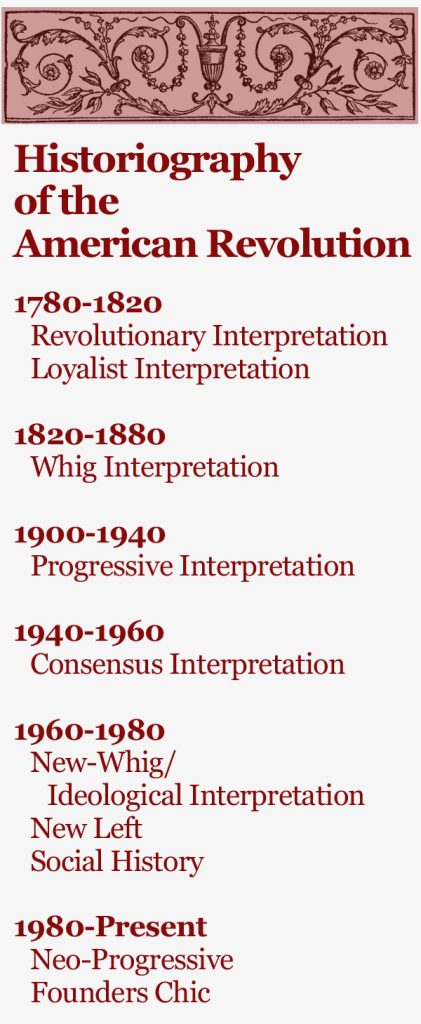 Historiography is, essentially, the history of history, or, more aptly, the history of history writing. How have historians in different times and places interpreted the causes and character of the Revolution differently? Historiography is the lifeblood of academic historians; however, the general reader often has little familiarity with it. Perhaps no other topic in American history has been subject to so many differing interpretations as the American Revolution. What follows is a summary of the different ways in which historians have interpreted the causes and character of the Revolution. It encompasses a debate that is as old as the Republic itself.
Historiography is, essentially, the history of history, or, more aptly, the history of history writing. How have historians in different times and places interpreted the causes and character of the Revolution differently? Historiography is the lifeblood of academic historians; however, the general reader often has little familiarity with it. Perhaps no other topic in American history has been subject to so many differing interpretations as the American Revolution. What follows is a summary of the different ways in which historians have interpreted the causes and character of the Revolution. It encompasses a debate that is as old as the Republic itself.
An understanding of the way historians have interpreted the Revolution differently can enrich the general reader’s own perspective and open up questions that promote critical and historical thinking on the part of the reader. In your reading on the American Revolution, you may have come across terms like “Progressives” or “republican synthesis” or “neo-Whigs.” If you’ve read dozens of narratives and biographies but find yourself wanting to dig even deeper into the analytical history of the American Revolution, this article is designed to give you a crash course in the historiography of the American Revolution.
Revolutionary Interpretation:
The two major contemporary historians of the Revolution were David Ramsay of South Carolina and Mercy Otis Warren of Massachusetts. Ramsay, in his The History of the American Revolution (1789), told the story of how virtuous “husbandmen, merchants, mechanics, and fishermen” won independence from the corrupt British. He saw the Revolution as a constitutional crisis brought on by the irreconcilability of Britain’s imperial interests and the colonists’ experience in self-government. The first female historian of the Revolution, Mercy Otis Warren, in her History of the Rise, Progress, and Termination of the American Revolution (1805), described the Revolution as a “boon of liberty.” Being the sister of James Otis, Jr. and the wife of Dr. James Warren, she had been personally involved in the coming of the Revolution and saw the actions of the British in the 1760s and 1770s as attempts to establish tyranny over the colonies. Having been participants in the events of which they wrote, both saw their histories as a moral story and warned their readers against eschewing virtue for the vices and corruption of the British.
Loyalist Interpretation:
Prominent Loyalists, too, wrote a number of contemporary histories of the Revolution, though some were only published posthumously including Thomas Hutchinson, the former royal governor of Massachusetts, Jonathan Boucher, Peter Oliver, and Joseph Galloway, a former member of the Continental Congress.[i] Unsurprisingly, these loyalist histories tended to focus on justifying British actions during the imperial crisis. Hutchinson was an exception. He believed that party politics in Britain contributed to the Ministry and Parliament’s discombobulated approach to the colonies. Galloway, however, believed that the disarray of imperial policy came largely from politicians and officials’ unfamiliarity with the colonies, its governments, and its people. All the Loyalist historians tended to agree that the creation of popular anti-British sentiment in the 1760s and early 1770s was the product of demagoguery by a small number of ill-designing men.
Whig Interpretation:
The Whig interpretation is best exemplified by a man whom Edmund Morgan called “the first great historian to deal with [the Revolution].”[ii] George Bancroft, like a number of historians and antiquarians of the pre-academic 19th century, used the leisure time his wealth afforded him to travel the country collecting and preserving primary source documents and to produce a massive multi-volume history of the United States.[iii] In the Whig interpretation, the underlying and unifying theme of American history was a Providential march toward liberty and democracy away from the tyranny and absolutism of the Old World. In the Revolution, “the Americans seized as their peculiar inheritance the traditions of liberty.”[iv] This interpretation held sway through much of the nineteenth century.
Imperial Interpretation:
In the early part of the twentieth century, a number of historians began looking at the colonial period from the British perspective, or, more accurately, they began to think of colonial history as imperial history. Unlike the Whigs, the imperial historians did not see a tyrannical ministry and Parliament bent on restraining the liberty of the colonists through harsh policies. Rather, historians such as George L. Beer, Charles Andrews, and Lawrence Gipson, studied British colonial policy and saw Britain’s attempts to manage trade and seek revenue from the colonies as reasonable policies, especially considering Britain’s war debt and colonists’ relatively light tax burden.[v]
Progressive Interpretation:
Also in the first decades of the twentieth century, a new interpretation arose in direct reaction to the Whig interpretation. The Progressive interpretation attempted to view the Revolution through the lenses of class conflict and economic interests. They also denied the notion that ideas had any real causal power and that the rhetoric of the revolutionaries was largely a cover for their own interests. In 1909, Carl Becker proffered his “dual revolution thesis,” writing, “The first was the question of home rule; the second was the question . . . of who should rule at home.”[vi] That is to say, Becker thought that, at the same time as colonists were struggling with Great Britain, there was also a class struggle occurring internally. A few years later, Charles Beard published an extended essay––more ruminative than researched––in which he argued that individual economic and class interests shaped the decisions made by delegates to the Constitutional Convention and the subsequent ratification process. The interpretation reached its apex in the work of Merrill Jensen, a second-generation Progressive, who argued that the American Revolution was “an internal revolution carried on by the masses of the people against the local aristocracy.”[vii] Progressives believed that the Revolution of 1776 was a radical, populist uprising and that the Constitutional Convention represented the elites’ attempt at counterrevolution.
Consensus Interpretation:
In the 1940s and 1950s, in reaction to the Progressives’ focus on conflict (and the rise of the Cold War), historians began looking for commonalities or consensus in the past. Louis Hartz found a broad scale consensus among colonists in the political philosophy of John Locke. Other consensus historians, like Daniel Boorstin, stressed the conservative nature of the American Revolution. Meanwhile, a few historians took on Progressive arguments directly including Forrest McDonald, who refuted Beard’s argument regarding economic interest and the Constitution, while Robert Brown tried to dispel the Progressives’ class conflict dynamic by arguing that a “middle-class democracy” had already existed before the Revolution.[viii]
Neo-Whig/Ideological Interpretation:
In 1953, Edmund S. Morgan argued that colonists’ arguments about constitutionality were not only genuine but that they were central to the Revolution.[ix] In a sense, Morgan’s work (as well as that of Douglass Adair) signaled to early American historians that it was okay to take ideas seriously (hence the somewhat derisive label, “neo-Whig”). One of the most definitive works of this new ideological interpretation was Bernard Bailyn’s The Ideological Origins of the American Revolution (1967). Bailyn argued that colonists’ ideology had its origins in the so-called “radical Whig” republican tradition in England, which instilled in them a strong fear of tyranny and conspiracies against their liberty. This was meant to explain why colonists reacted as they did to Britain’s new imperial policies during the 1760s. Bailyn and others’ focus on “republicanism” (which together came to be known as the “republican synthesis”) was challenged by historians such as Joyce Appleby, who argued that the liberalism of John Locke was at least as, if not more, fundamental to the character of the Revolution. This “republicanism-liberalism” debate lasted for well over decade and, at times, became quite heated.[x]
New Left/Neo-Progressive Interpretations:
In the late 1960s and 1970s, “social history,” which focused on the lives of everyday persons, became predominant. At the same time, the Civil Rights movement and the feminist movement helped provide a spark for a new generation of historians to study the history of race and slavery in early America, as well as women’s history. Around the same time, young historians––most notably Jesse Lemisch and Staughton Lynd––involved in New Left politics engaged in this “history from the bottom up” in an effort to recover the agency of laboring class colonists.[xi] Similarly, Mary Beth Norton and Linda Kerber both published books in 1980 about the impact of the Revolution on women.[xii] In the 1980s and 1990s, there was a resurgence of interest in class conflict and economic aspects of the Revolution. Neo-Progressive historians such as Gary Nash, Ed Countryman, and Woody Holton have combined the issues of the Progressive interpretation with the social history’s concern for non-elites.[xiii] They’ve argued that ordinary Americans during the Revolution were quite radical and in pursuit of their own interests, thereby integrating them into the larger political narrative of the Revolution. While neo-Progressives continue to write important works, in the last twenty years there has been no dominant school or interpretation that has defined the study of the Revolution. Rather, there are many sub-fields such as imperial history, Native American history, history of the West, and religion, which are producing exciting works that are broadening our understanding of the Revolution and early America, in general.
Founders Chic:
“Founders Chic” is not a historiographical school; it is a pejorative term given to a number of popular histories of the founding that began appearing in the 1990s. In that decade, there was an explosion of interest among the general reading public for books about the founding. The works that resonated most––by authors such as David McCullough, Joseph Ellis, Richard Brookhiser, and Ron Chernow, among others––were often biographies or narratives that focused on the so-called “character” of both individual founders and the founding generation. One critic mockingly referred to these works as “Federalist Chic” because they tended to glorify Federalists like John Adams and Alexander Hamilton while portraying Republicans in a much more critical and darker light, particularly Thomas Jefferson. A number of academic historians––including Gordon Wood, Edmund Morgan, and John Ferling––wanting to reach a broader audience and upset that works by authors not trained in history were selling millions of copies while their books sold only a few hundred, published many solid works of both narrative and biography, but none found the kind of audience as McCullough or Chernow.[xiv]
As we can see, the way historians have interpreted the Revolution has inevitably been influenced by the times in which they lived. The English historian, E. H. Carr, wrote, “Before you study the history, study the historian” and their own “historical and social environment.” This is true in all fields of history. Nevertheless, each of these interpretations made unique contributions to the ways in which we understand the Revolution today. For the general reader wanting to explore the historiography of the American Revolution further, I suggest: Alfred F. Young and Gregory H. Nobles, Whose American Revolution Was It? Historians Interpret the Founding (2011), Alan Gibson, Interpreting the Founding: Guide to the Enduring Debates over the Origins and Foundations of the American Republic (2006), and Gwenda Morgan, The Debate on the American Revolution (2007).
[i] Thomas Hutchinson, The History of the Province of Massachusetts Bay, from 1749 to 1774 Comprising a Detailed Narrative of the Origin and Early Stages of the American Revolution, ed. John Hutchinson (London: J. Murray, 1828); Peter Oliver, Peter Oliver’s Origin and Progress of the American Rebellion: A Tory View, eds. Douglass Adair and John A. Schutz (San Marino, Ca.: Huntington Library, 1961); Jonathan Boucher, A View of the Causes and Consequences of the American Revolution (London: Printed for G. G. and J. Robinson, Paternoster-Row, 1797); Joseph Galloway, Historical and Political Reflections on the Rise and Progress of the American Rebellion (London, 1780).
[ii] Edmund S. Morgan, The American Revolution: A Review of Changing Interpretations (Washington D.C., 1958), 1.
[iii] It was during this period that Peter Force compiled and published American Archives, a collection of primary sources mostly covering 1774 to 1776 and Charles Evans compiled and published American Bibliography, a 14-volume catalogue of every known surviving piece of printed matter produced in the colonies and states through 1800.
[iv] George Bancroft, History of the United States, from the Discovery of the Continent, 10 vols. (New York: D. Appleton and Company, 1889), IV, 3.
[v] George L. Beer, British Colonial Policy, 1754-1765 (New York, 1907); Charles M. Andrews, The Colonial Background of the American Revolution (New Haven, 1931); Lawrence Gipson, The Coming of the American Revolution (New York, 1954).
[vi] Carl L. Becker, The History of Political Parties in the Province of New York, 1760-1776 (Madison, 1909), 22.
[vii] Merrill Jensen, The Articles of Confederation: An Interpretation of the Social-Constitutional History of the American Revolution (Madison: University of Wisconsin Press, 1940), 5.
[viii] Louis Hartz, The Liberal Tradition in America: An Interpretation of American Political Thought Since the Revolution (New York: Harcourt, Brace, and World, 1955); Daniel Boorstin, The Genius of American Politics (Chicago: University of Chicago Press, 1953); Forrest McDonald, We The People: The Economic Origins of the Constitution (Chicago: University of Chicago Press, 1958); Robert E. Brown, Middle-Class Democracy and the Revolution in Massachusetts, 1691-1780 (Ithaca: Cornell University Press, 1955). For an in-depth look at the historiography of the Revolution up until this point, see Jack P. Greene, “The Flight from Determinism: A Review of Recent Literature on the Coming of the American Revolution,” in Interpreting Early America: Historiographical Essays (Charlottesville: University of Virginia Press, 1996), 311–333.
[ix] Edmund S. Morgan, The Stamp Act Crisis: Prologue to Revolution (Chapel Hill: University of North Carolina Press, 1953).
[x] The republican synthesis stressed the importance of the notion of “virtue,” i.e., a successful republic required virtuous citizens willing to forego their own private interests in favor of the “public good.” Liberalism stressed individualism and that the public good arose when individuals sought their own private interests in a market economy.
[xi] Jesse L. Lemisch, “Jack Tar in the Streets: Merchant Seamen in the Politics of Revolutionary America,” The William and Mary Quarterly, Third Series 25, no. 3 (1968): 371–407; Staughton Lynd, “The Mechanics in New York Politics, 1774-1788,” Labor History 5, no. 3 (1964): 225–246.
[xii] Mary Beth Norton, Liberty’s Daughters: The Revolutionary Experience of American Women, 1750-1800 (Ithaca: Cornell University Press, 1980); Linda K. Kerber, Women of the Republic: Intellect and Ideology in Revolutionary America (Chapel Hill: University of North Carolina Press, 1980).
[xiii] Gary B. Nash, The Unknown American Revolution: The Unruly Birth of Democracy and the Struggle to Create America (New York: Viking, 2005); Edward Countryman, A People in Revolution: The American Revolution and Political Society in New York, 1760-1790 (New York: W. W. Norton & Company, 1989); Woody Holton, Unruly Americans and the Origins of the Constitution (New York: Hill and Wang, 2008).
[xiv] Gordon Wood, Revolutionary Characters: What Made the Founders Different (New York: Penguin, 2007); Edmund S. Morgan, Benjamin Franklin (New Haven: Yale University Press, 2002); John Ferling, A Leap in the Dark: The Struggle to Create the American Republic (New York: Oxford University Press, 2003).


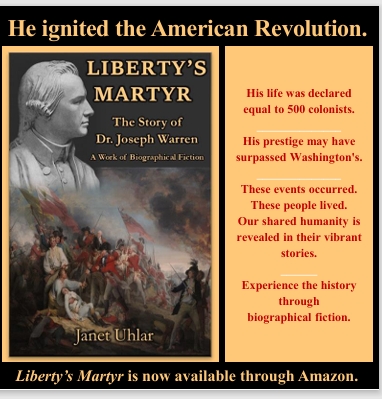
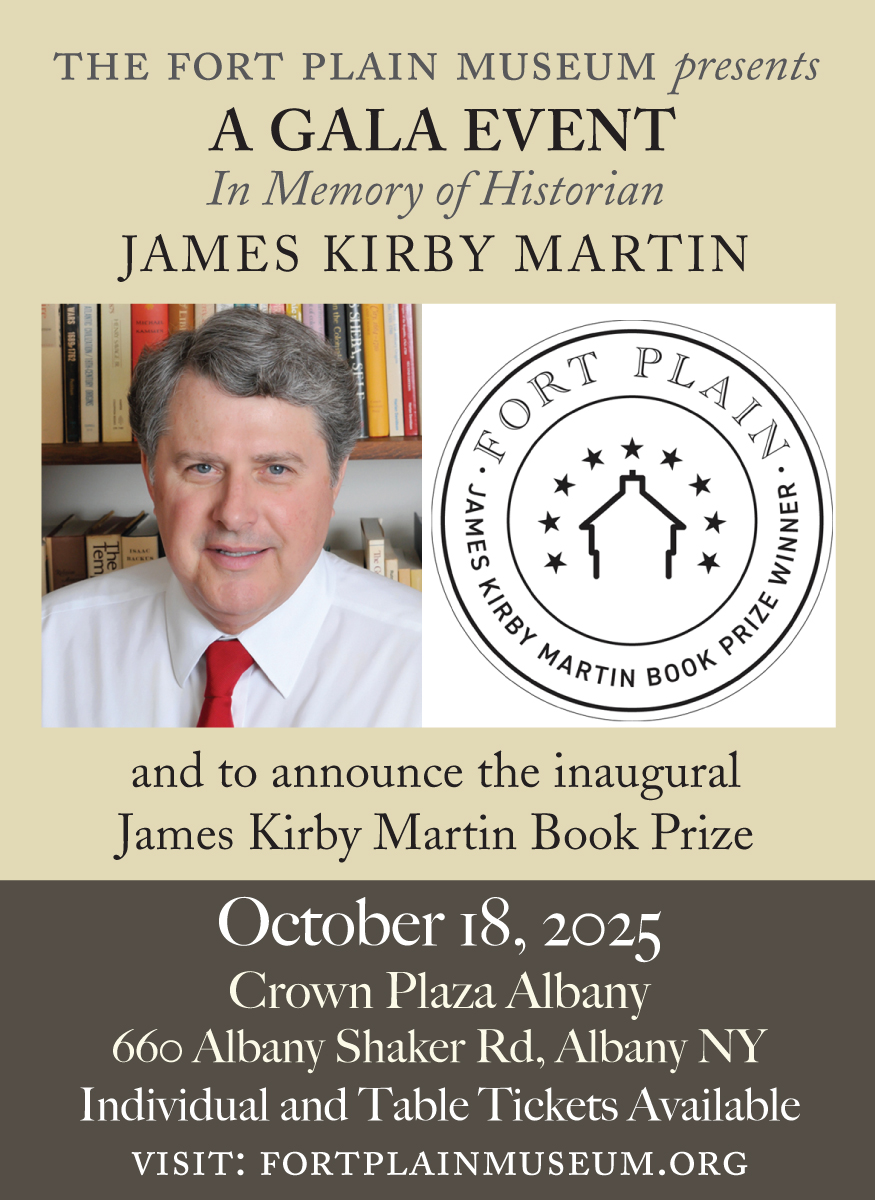

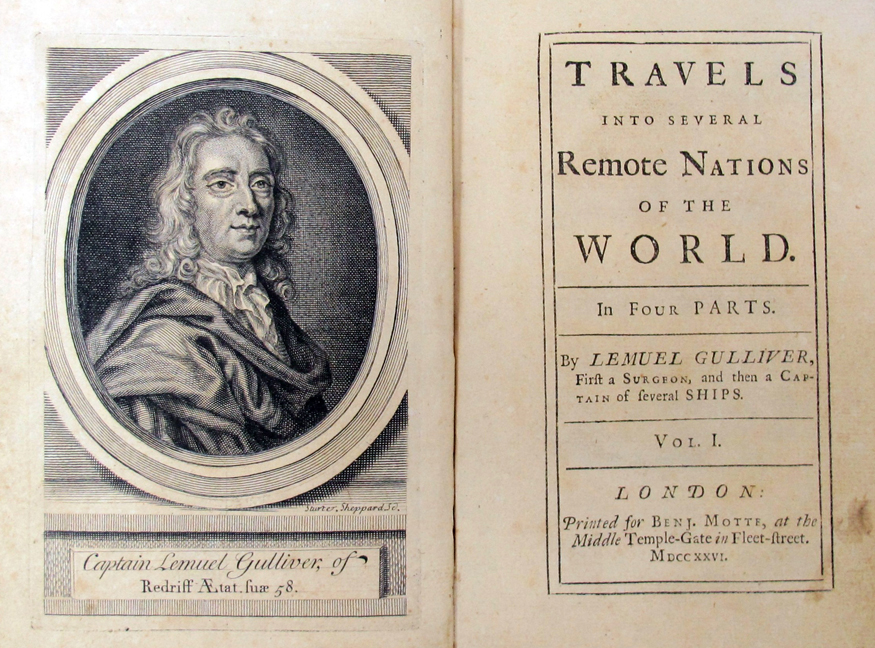
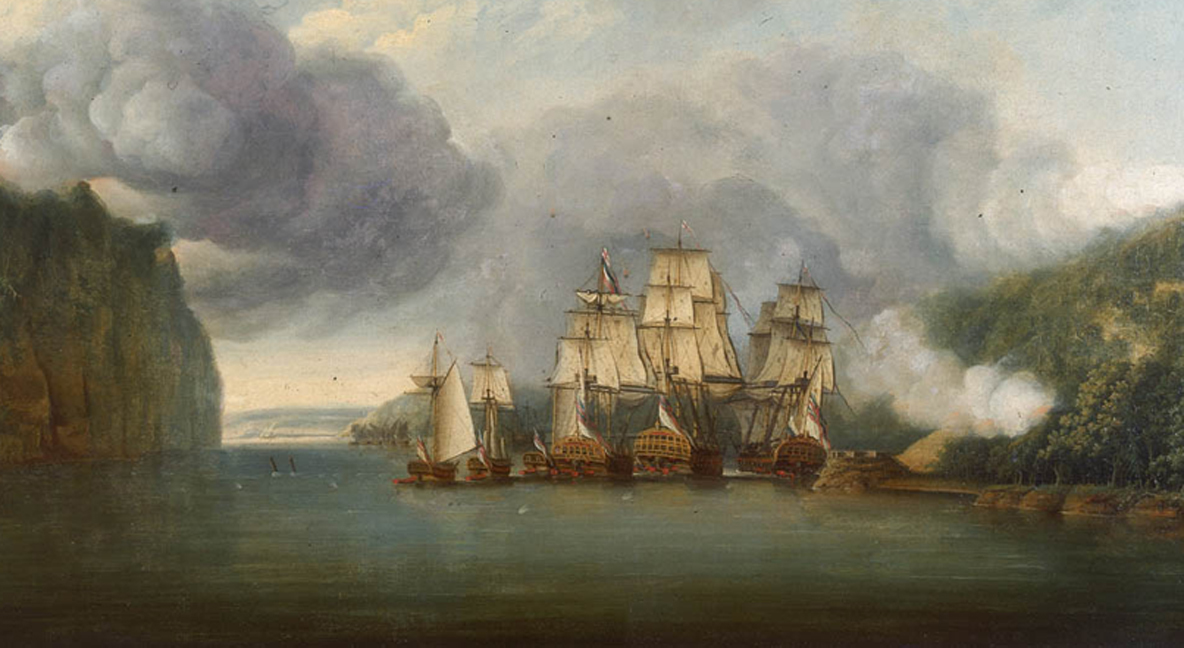
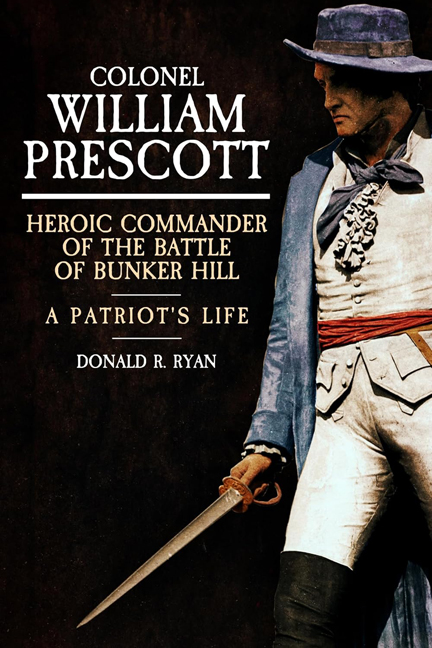

12 Comments
Thank you for an excellent article. Historiography was my favorite course in college and, in my view, the quintessential history major’s guide. It was the last class in my senior year and felt it should be taught first. I’m reminded of Santayana’s quotation to the effect that history is a pack of lies written by people who weren’t there about events that never happened. My uncle dropped that one on me when he knew I’d be old enough to understand that there was a problem with written history with the hope that my intellect would evolve to properly to one day be able to resolve it. But Santayana also wrote “Those who cannot remember the past are condemned to repeat it.” To me, History is the cautionary tale of human existence. When historians write, they were, for the most part, not there. If they were, they were reporting current events. They don’t, or at least most, don’t tell lies. Perhaps, however, they slant a bit or choose source material that supports a particular point of view. The events themselves, of course, happened, though not necessarily the manner in which an historian chooses to write about them. This is why original sources research must inform any good study. Nevertheless, the researching of historical subjects is both a good mystery and an analysis of ourselves even though it’s important to ‘consider the source.’ Historiography gives us leave to report on the reporters and that helps us sort out the ‘pack of lies.’ Oddly enough, I’ve always found Francis Parkman and John D. Hicks fascinating. Parkman wrote history in a literary form employing dramatic descriptions within his works. Hicks, on the other hand, so distorted the life of slavery (something about being content sitting in the shade of a tree eating watermelon or dancing to native beats) that I saw how inimical the writing of history can be in establishing myths (as noted in recent posts here) and unfortunate stereotypes. Historiography helps us appreciate that humans write history for all sorts of reasons and it’s up to the reader to discern why, in addition to the who, what, when, where.
I enjoyed the article, as I do your blog sir. I find it interesting the way we interpret history through the years. From a semi-hero worship from some (George Washington Park Custis comes to my mind, but it is easy to see why it happened in his case) to the attempt to impact our government and administrations during the Viet Nam Era by pointing out mistakes of imperialism. Again, very nice, thought provoking article.
I landed upon this very helpful article after purchasing 1775 by Kevin Phillips and encountering in his introduction references to Neo-Whig, Consensus and Progressive historiography. So thank you.
After reading this article, what comes to mind though is why any of these interpretations are raised to a distinct level to the point where they get their own title, as if they are capable of maintaining a stable independent solo status. It is obvious that they all have some application to the totality of the stimulus that produced the Revolution. And rather than arguing for one or the other, should be synthesized into a consistent whole. After all, people don’t live the experience of the “Whig” interpretation, or the “Progressive” interpretation. Without realizing it, they live a combination. And that also explains why authors like McCullough sell more books — he writes about what people actually live, not the abstract rather dry academic super-specialized interpretations between which theorists debate.
Hi Michael, not sure if you’re monitoring comments after all this time ….
I thought this would be a great article for my Senior Seminar students who remain confused about historiography. And it will be so thank you. But, and I’m sorry to nitpick, pretty sure Mercy Otis Warren was neither the *brother* of James Otis, Jr. nor the *husband* of Dr. James Warren, unless she was in which case you have an awesome book to write.
Best,
Robyn
Thanks for commenting, Robyn. Good catch on Mercy Otis Warren. Fixed.
The historiographical guide is an excellent resource, and it’s good to see it again. Two sections might benefit from some additional information. The Loyalist section might include Thomas Jones’ “History of New York during the Revolutionary War”. Jones, a judge of the New York Supreme Court before the war, wrote his bitter, acerbic take on the Revolutionary movement while an exile in England, though it was only published in the late nineteenth century. While he excoriates the Whig/Patriots as petty, disingenuous, selfish people whose pretentions to respectability were a ludicrous sham, he was nearly as censorious of the British, whose venality and heavy-handedness he blamed for alienating Whigs, Tories and neutrals alike—not to mention losing the contest.
In the light of recent developments in academic history, the section on “Founder Chic” deserves some further attention. “Founder Chic” was coined by academic historians as a facetious label for works, either by non-affiliated authors such as McCullough and Philbrick, or those connected with colleges and universities, such as Ellis and Wood, whose generally positive take on the leaders and course of the Revolution had become unfashionable. (Indeed, Wood has been nearly expelled from the guild.) Recently, a contributor to “The Junto”, a blog created by self-described “young Americanists,” further dismissed founder chic and military-centered histories, especially by non-institutionally affiliated authors, as “Uncle Books.” The term removes work by Ferling, Ellis, McCullough, Fleming, Phibrick et. al. from contention as serious works of history, and deems them fit only as gifts for aging relatives, who, ignorant of current fashions in historical scholarship, remain content with narratives presenting the Revolution and its participants in more positive and traditional guises as the founding generation of the nation. (That such books typically sell better and make more money is no doubt a further source of outrage and disappointment,)
Indeed, the divide between the academically connected (or wannabe connected) historians, and those who consume “popular” history (though many find both fruitful) seems to be widening. Contemporary academic history is increasingly dominated by a new interpretation which might be called, the “Great Mistake” or “Calamity” school of American Revolutionary historiography. A good example may be found in a recent posting on “The Junto” (not the only home for such viewpoints, and worth a read in any case.) A short essay on American political history refers to Gordon Wood’s New York Times review of Alan Taylor’s recently published “American Revolutions”. Wood concluded that Taylor’s work renders the Revolution “sordid, racist and divisive,” and unfit as an “inspiration to the nation.” Just so, the blogger maintains, arguing that “a vision of the American Revolution that attempts to fully incorporate all the experiences recovered by the expansion of political history [e.g. Taylor] over the last half century cannot help but depict, as Wood puts it, the new republic as ‘sordid, racist and divisive’.” This interpretation of the creation of the United States, and much of its history into the twentieth century, is now dominant in academic American history.
As the author of this piece, I would like to point out that I have recently created a timeline of the historiography of the American Revolution which readers may also find useful: http://www.bit.ly/AmRevHistTL
Michael, the historiography timeline is outstanding. Thanks for sharing!
Michael, the timeline is superb and I’ve bookmarked it. I think it should be in the collection of every historian of the American Revolution.
I’d be interested in knowing where JAR thinks they fit into these categories.
Cheers, Jax
JAR is the product of many authors with diverse specialties and points of view; as such, the publication as a whole defies categorization. We’re characterized most closely by the article’s assertion, “in the last twenty years there has been no dominant school or interpretation that has defined the study of the Revolution. Rather, there are many sub-fields such as imperial history, Native American history, history of the West, and religion, which are producing exciting works that are broadening our understanding of the Revolution and early America, in general.”
Thank you Sir for this constuctive article. Are these interpretations the same as the approaches to the American Revolutions?